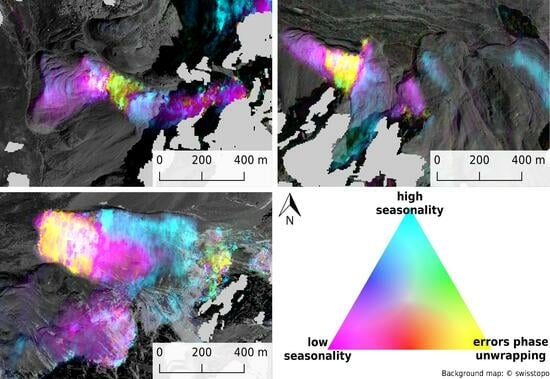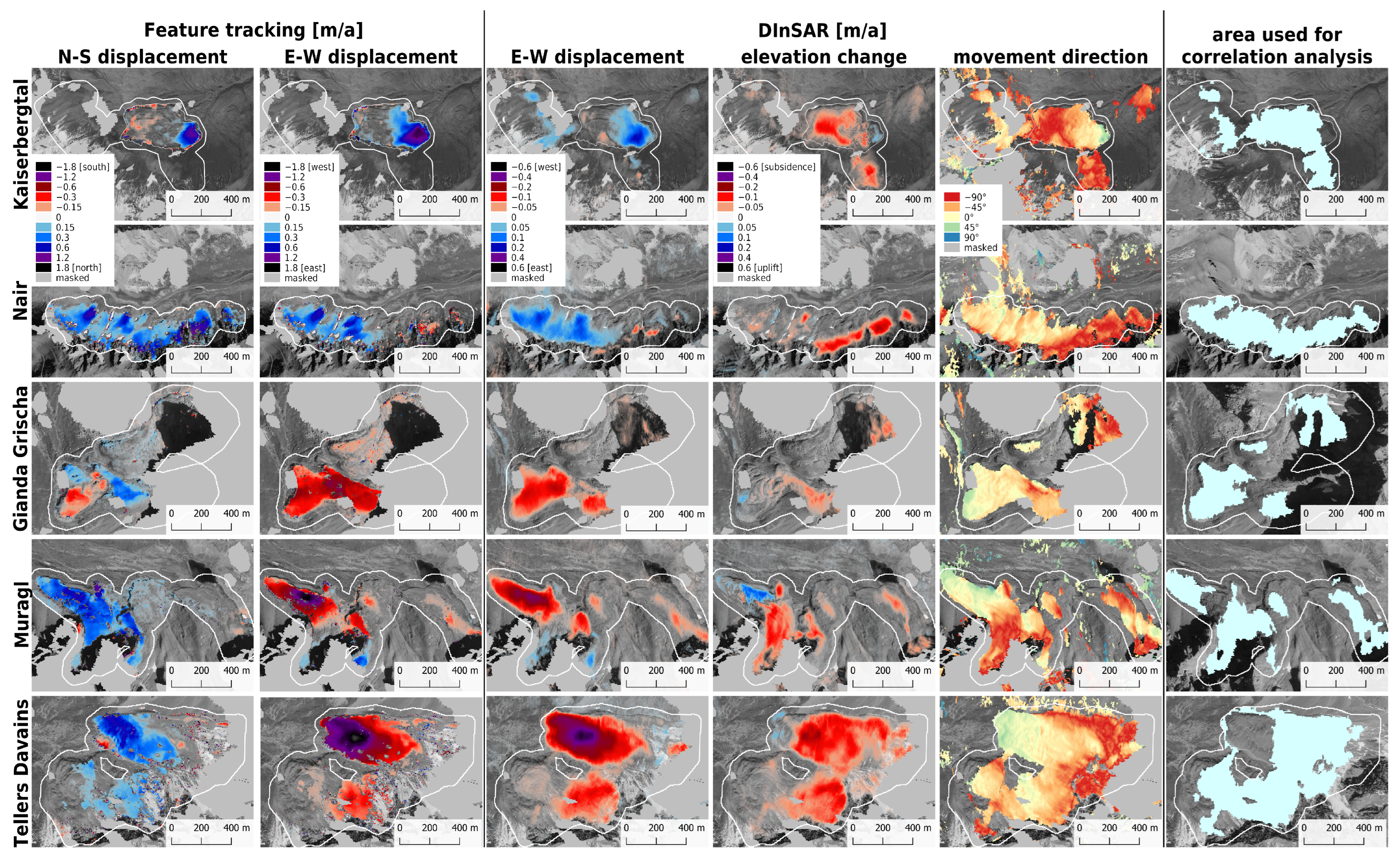Deciphering Small-Scale Seasonal Surface Dynamics of Rock Glaciers in the Central European Alps Using DInSAR Time Series
Abstract
1. Introduction
2. Study Areas
2.1. Kaiserbergtal
2.2. Grison Study Sites
3. Data and Methods
3.1. Differential SAR Interferometry Displacement Time Series Generation
3.2. Displacement Decomposition
3.3. Reference Data Generation Using Feature Tracking and DEM Differencing
3.4. Calculation of Seasonal Movement
3.5. Correlation Analysis of Spatiotemporal Dynamics
4. Results
4.1. Comparison of DInSAR Displacement with Feature Tracking and DEM Differencing
4.1.1. Kaiserbergtal
4.1.2. Grison Sites
4.2. Seasonal Movement
4.3. Correlation Analysis
5. Discussion
5.1. Accuracy of the Yearly DInSAR Displacement Rate and Its Decomposition
- (i)
- The FT product is unable to detect displacement in case of sun shadow (Grischa, Muragl; Figure 5d,g) or snow cover (Davains; Figure 5k). These areas have to be masked out in the FT approach due to a failure in detecting features because of the strong difference between the images used, whereas DInSAR is independent from lighting conditions. Further, at Gianda Grischa we could visually identify a systematic error in the displacement detection of the northern rock glacier, which is caused by different sun illumination angles between the two acquisitions resulting in shifted shadows of the blocks on the surface (Figure 5d). Hence, inaccuracies of the DInSAR product are rather overestimated, as we do not correct for these artefacts induced by the FT product.
- (ii)
- DInSAR shows systematic underestimation of the movement in areas with strong and abrupt changes in displacement values such as at fast moving rock glacier parts near the front (Kaiserbergtal, Davains; Figure 4b and Figure 5l) or adjacent to the lateral boundaries (Muragl; Figure 5h). In these cases, we still observe reduced velocities; it is only at Gianda Grischa that the movement of the middle part of the southern rock glacier is not detected at all (Figure 5e). Such effects are caused by errors in the phase unwrapping process. We observe that the upper detectable boundary of DInSAR displacement is lower than the previously described [34,43] single full phase cycle 2, which represents about a 1.7 m/a displacement. At our study sites, phase unwrapping errors start to occur at already half a phase cycle (0.9 m/a), but can occur at down to even less than 0.4 m/a (Figure 5) in unfavorable conditions (e.g., Gianda Grischa). More unwrapping errors in interferograms with longer temporal baselines, which were used to bridge gaps with low coherence due to snowfall events during summer, could partially explain the reduced sensitivity. This highlights the importance of dense C-Band time series for rock glacier monitoring. Phase unwrapping tends to fail preferably at the margins of rock glaciers, where abrupt phase changes occur along with a decorrelation of the signal due to the instability of the surface. Unwrapping errors occur mostly along East-West boundaries due to the reduced number of adjacent pixels in this direction, which is caused by the uneven pixel size (2.3 m in range, 13.9 m in azimuth). Thereby, distinct boundaries in the north-south direction develop for unwrapping affected areas (e.g., Kaiserbergtal, Gianda Grischa, Muragl; Figure 6). Projection to squared pixels in Cartesian coordinates before unwrapping might reduce this tendency and could improve results, but the interpolation and oversampling in an azimuth direction of the wrapped interferograms might cause new artefacts. Therefore, we did not carry out an adapted workflow. Besides such changes in preprocessing, advanced methods for phase unwrapping such as deep-learning-based approaches (e.g., [86,87]) could improve the successful unwrapping of the interferograms.
- (iii)
- The spatial patterns of the two independent datasets match very well. Even smaller areas and those with weaker displacement rates (e.g., eastern part of Muragl; Figure 5g,h) are congruently detected by both methods. Our results show similar accuracies as other studies with the SD ranging from 0.23 m up to 0.33 m after scaling compared to, e.g., the results of Strozzi et al., 2020 [34] with an SD ranging from 0.20 m to 0.34 m. It is only at Davains that higher inaccuracies are observed because a larger proportion of the investigated area is affected by phase unwrapping issues (Figure 5k–m). However, the scatterplot shows similar good agreement for lower displacement rates (Figure 5m). Hence, the higher spatial sampling does not lead to higher inaccuracies in the aggregated yearly displacement rate and our approach is able to accurately detect movement. Based on an RMSE of around 10 cm (except Davains with more unwrapping issues) and visual inspection of value ranges in stable areas, we state that the lower detectable boundary with 6d interferogram stacks is at around 10 cm/a displacement, which is the limit for active rock glaciers [15]. Our results indicate slightly higher sensitivity than other recent studies [34,43], which might be due to the longer time series used in the stacking procedure [41,42,77,78] which results in a stronger dampening of arbitrary phase contributions from atmosphere or noise. Discriminating areas with displacement rates of less than 10 cm/a need longer temporal baselines [34,43] and more sensitive methods such as small baseline subset (SBAS) InSAR should be used [41,42,45,88].
- (iv)
- Visual assessment of the displacement maps shows that DInSAR lacks the ability to detect very high-resolution variabilities (e.g., Kaiserbergtal for the elevation change—Figure 4c,d, Nair for outlines of the smaller active lobes—Figure 5a,b). The coverage of such high-resolution spatial variations is more limited in the north-south direction due to the lower azimuth resolution (13.9 m) compared to the range (2.3 m) of Sentinel-1. However, the extent and variations on the scale of a few decameters are captured well. Moreover, the systematic difference in the distribution of horizontal and vertical displacement at Kaiserbergtal (subsidence in western part; increasing horizontal movement towards southeast) agrees well in both methods (Figure 4). Spatial agreement in E-W displacement is also good in areas where less suitable conditions exist for DInSAR, such as areas adjacent to widespread layover and shadow at Gianda Grischa or strong northern orientation at Nair (Figure 5a,b,d,e). Even active areas with a direct northern orientation are highly detectable due to their vertical displacement contribution (see Appendix A Figure A1), which is evident for nearly all rock glaciers. However, neglecting the N-S displacement component leads to incorrect estimates, especially in the vertical displacement. This is twofold: (1) neglecting N-S displacement leads to a systematic increase in the vertical displacement component due to their similar behavior in LOS. (2) The contribution of slope in N-S direction to the vertical displacement component is neglected and, therefore, leads to an overestimation of elevation change in areas with strong N-S displacement.
5.2. Insights from Spatial Patterns of Movement Direction and Seasonality
6. Conclusions
Author Contributions
Funding
Data Availability Statement
Acknowledgments
Conflicts of Interest
Abbreviations
| APS | Atmospheric Phase Screen |
| a.s.l. | above sea level |
| DEM | Digital Elevation Model |
| DInSAR | Differential SAR Interferometry |
| ECV | Essential Climate Variable |
| EMT | Environmental Motion Tracking |
| EOS | end of snow cover |
| E-W | East-West |
| FT | Feature Tracking |
| IPA | International Permafrost Association |
| LOS | Line of Sight |
| MCF | Minimum Cost Flow |
| N-S | North-South |
| OTB | Orfeo Toolbox |
| RGV | Rock glacier velocity |
| RMSE | Root Mean Squared Error |
| SAR | Synthetic Aperture Radar |
| SBAS | Small Baseline Subset |
| sd | Standard Deviation |
| SLC | Single Look Complex |
| UAV | unpiloted aerial vehicle |
| U-D | Up-Down |
Appendix A
Appendix A.1
Appendix A.2
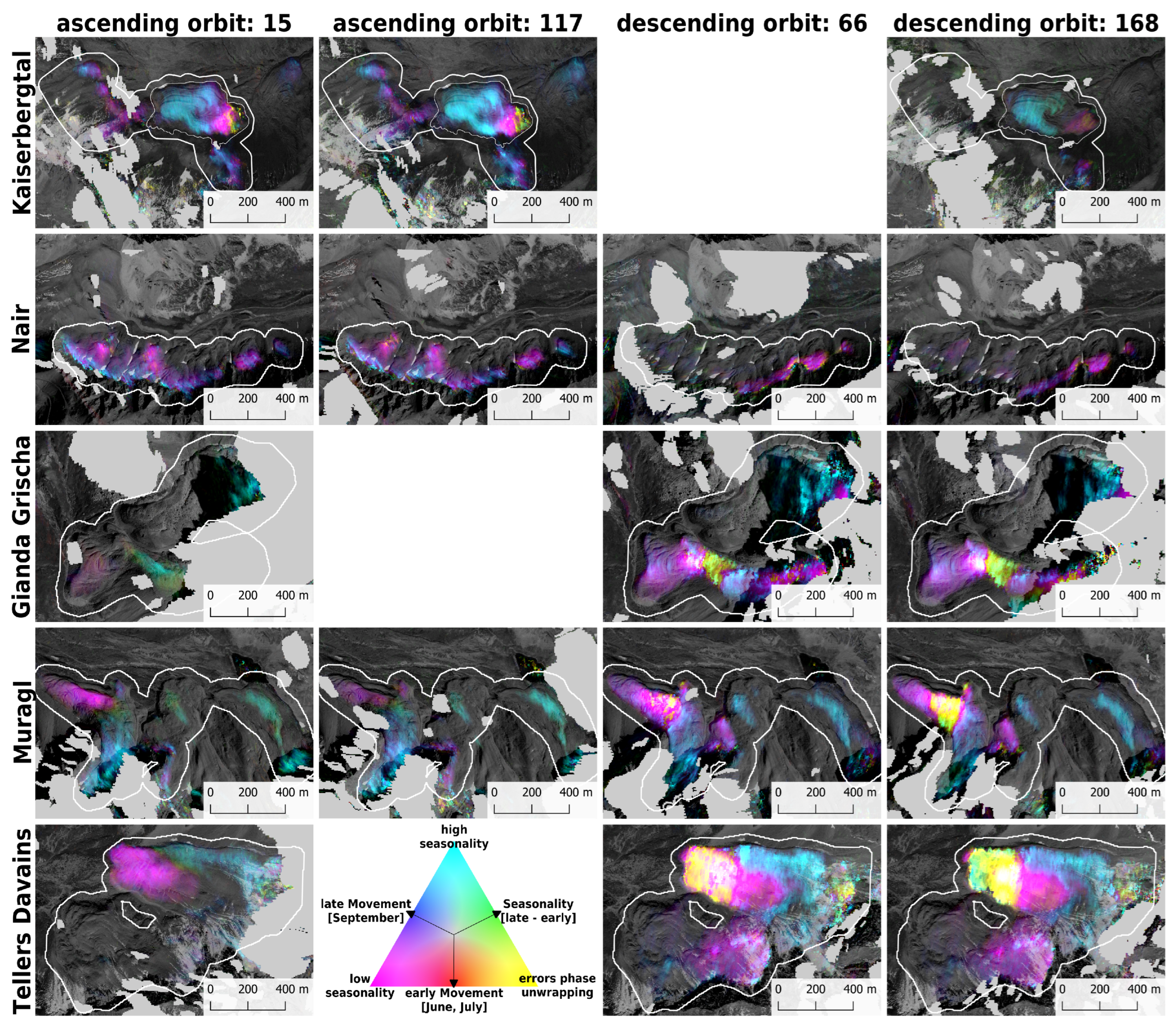
Appendix A.3
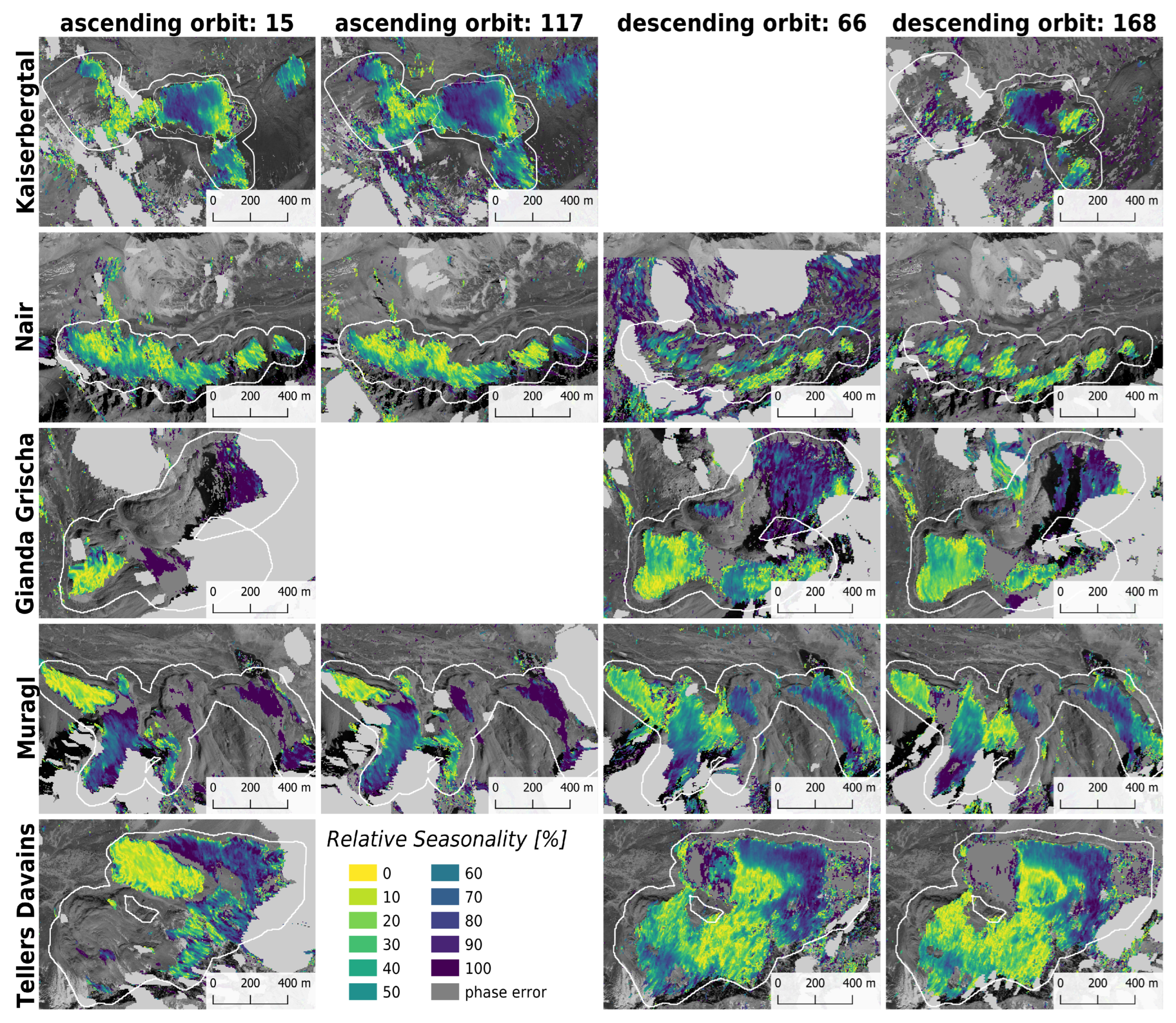
Appendix B
| Software | Version | Processing Steps |
|---|---|---|
| SNAP (accessed via snappy) | v8.0.3 | Preprocessing: Apply Orbit File, TOPSAR Split & Deburst Coregistration: Backgeocoding, Enhanced Spectral Diversity Interferogram: Calculation of Phase, Topographic Phase removal, Goldstein Phase Filter Projection to map coordinates |
| snaphu | v2.0.4 | Phase unwrapping (MCF algorithm) |
| pyrate | v0.5.0 | Reference Phase: Detection of stable area; Calculation of Reference Phase Corrections: Mask low coherence areas; orbit error correction Atmospheric Phase Screen: spatial and temporal low-pass gaussian filter Conversion of phase to displacement |
| Agisoft Metashape Professional | 1.7.2 | Structure from motion point cloud generation from UAV imagery Generation of digital elevation model |
| Environmental Motion Tracker | 0.9.3 | UAV hillshade/orthophoto image coregistration Feature Tracking in coregistered UAV hillshade/orthophoto |
| Orfeo Toolbox | 8.1.0 | Preparation of dataset for segmentation: stacking, normalization Segmentation of rock glacier areas into segments of similar dynamics |
References
- French, H.M. The Periglacial Environment; John Wiley & Sons: Hoboken, NJ, USA, 2017. [Google Scholar]
- Etzelmüller, B.; Guglielmin, M.; Hauck, C.; Hilbich, C.; Hoelzle, M.; Isaksen, K.; Noetzli, J.; Oliva, M.; Ramos, M. Twenty years of European mountain permafrost dynamics—The PACE legacy. Environ. Res. Lett. 2020, 15, 104070. [Google Scholar] [CrossRef]
- World Meteorological Organization (WMO). The 2022 GCOS ECVs Requirements (GCOS 245). Available online: https://library.wmo.int/doc_num.php?explnum_id=11318 (accessed on 27 January 2023).
- Hock, R.; Rasul, G.; Adler, C.; Cáceres, B.; Gruber, S.; Hirabayashi, Y.; Jackson, M.; Kääb, A.; Kang, S.; Kutuzov, S.; et al. High Mountain Areas; The Intergovernmental Panel on Climate Change (IPCC); Cambridge University Press: Cambridge, UK, 2019. [Google Scholar]
- Wagner, T.; Kainz, S.; Helfricht, K.; Fischer, A.; Avian, M.; Krainer, K.; Winkler, G. Assessment of liquid and solid water storage in rock glaciers versus glacier ice in the Austrian Alps. Sci. Total. Environ. 2021, 800, 149593. [Google Scholar] [CrossRef]
- Delaloye, R.; Lambiel, C.; Gärtner-Roer, I. Overview of rock glacier kinematics research in the Swiss Alps. Geogr. Helv. 2010, 65, 135–145. [Google Scholar] [CrossRef]
- Beniston, M.; Farinotti, D.; Stoffel, M.; Andreassen, L.M.; Coppola, E.; Eckert, N.; Fantini, A.; Giacona, F.; Hauck, C.; Huss, M.; et al. The European mountain cryosphere: A review of its current state, trends, and future challenges. Cryosphere 2018, 12, 759–794. [Google Scholar] [CrossRef]
- Philipp, M.; Dietz, A.; Buchelt, S.; Kuenzer, C. Trends in Satellite Earth Observation for Permafrost Related Analyses—A Review. Remote. Sens. 2021, 13, 1217. [Google Scholar] [CrossRef]
- Haeberli, W.; Hallet, B.; Arenson, L.; Elconin, R.; Humlum, O.; Kääb, A.; Kaufmann, V.; Ladanyi, B.; Matsuoka, N.; Springman, S.; et al. Permafrost creep and rock glacier dynamics. Permafr. Periglac. Process. 2006, 17, 189–214. [Google Scholar] [CrossRef]
- Bertone, A.; Barboux, C.; Bodin, X.; Bolch, T.; Brardinoni, F.; Caduff, R.; Christiansen, H.H.; Darrow, M.M.; Delaloye, R.; Etzelmüller, B.; et al. Incorporating InSAR kinematics into rock glacier inventories: Insights from 11 regions worldwide. Cryosphere 2022, 16, 2769–2792. [Google Scholar] [CrossRef]
- Barsch, D. Rockglaciers: Indicators for the Present and Former Geoecology in High Mountain Environments; Springer Science & Business Media: Berlin/Heidelberg, Germany, 2012. [Google Scholar]
- Vivero, S.; Lambiel, C. Monitoring the crisis of a rock glacier with repeated UAV surveys. Geogr. Helv. 2019, 74, 59–69. [Google Scholar] [CrossRef]
- Marcer, M.; Cicoira, A.; Cusicanqui, D.; Bodin, X.; Echelard, T.; Obregon, R.; Schoeneich, P. Rock glaciers throughout the French Alps accelerated and destabilised since 1990 as air temperatures increased. Commun. Earth Environ. 2021, 2, 1–11. [Google Scholar] [CrossRef]
- Groh, T.; Blöthe, J.H. Rock Glacier Kinematics in the Kaunertal, Ötztal Alps, Austria. Geosciences 2019, 9, 373. [Google Scholar] [CrossRef]
- RGIK—Kinematic. Optional Kinematic Attribute in Standardized Rock Glacier Inventories, IPA Action Group Rock Glacier Inventories and Kinematics. Available online: https://bigweb.unifr.ch/Science/Geosciences/Geomorphology/Pub/Website/IPA/CurrentVersion/Current_KinematicalAttribute.pdf (accessed on 16 February 2023).
- Kaufmann, V.; Kellerer-Pirklbauer, A.; Seier, G. Conventional and UAV-Based Aerial Surveys for Long-Term Monitoring (1954–2020) of a Highly Active Rock Glacier in Austria. Front. Remote Sens. 2021, 2, 33. [Google Scholar] [CrossRef]
- Haberkorn, A.; Kenner, R.; Noetzli, J.; Phillips, M. Changes in Ground Temperature and Dynamics in Mountain Permafrost in the Swiss Alps. Front. Earth Sci. 2021, 9, 626686. [Google Scholar] [CrossRef]
- Fleischer, F.; Haas, F.; Piermattei, L.; Pfeiffer, M.; Heckmann, T.; Altmann, M.; Rom, J.; Stark, M.; Wimmer, M.H.; Pfeifer, N.; et al. Multi-decadal (1953–2017) rock glacier kinematics analysed by high-resolution topographic data in the upper Kaunertal, Austria. Cryosphere 2021, 15, 5345–5369. [Google Scholar] [CrossRef]
- Wirz, V.; Gruber, S.; Purves, R.S.; Beutel, J.; Gärtner-Roer, I.; Gubler, S.; Vieli, A. Short-term velocity variations at three rock glaciers and their relationship with meteorological conditions. Earth Surf. Dyn. 2016, 4, 103–123. [Google Scholar] [CrossRef]
- Kenner, R.; Phillips, M.; Beutel, J.; Hiller, M.; Limpach, P.; Pointner, E.; Volken, M. Factors Controlling Velocity Variations at Short-Term, Seasonal and Multiyear Time Scales, Ritigraben Rock Glacier, Western Swiss Alps. Permafr. Periglac. Process. 2017, 28, 675–684. [Google Scholar] [CrossRef]
- Buchli, T.; Kos, A.; Limpach, P.; Merz, K.; Zhou, X.; Springman, S.M. Kinematic investigations on the Furggwanghorn Rock Glacier, Switzerland. Permafr. Periglac. Process. 2018, 29, 3–20. [Google Scholar] [CrossRef]
- Cicoira, A.; Beutel, J.; Faillettaz, J.; Vieli, A. Water controls the seasonal rhythm of rock glacier flow. Earth Planet. Sci. Lett. 2019, 528, 115844. [Google Scholar] [CrossRef]
- Kenner, R.; Pruessner, L.; Beutel, J.; Limpach, P.; Phillips, M. How rock glacier hydrology, deformation velocities and ground temperatures interact: Examples from the Swiss Alps. Permafr. Periglac. Process. 2020, 31, 3–14. [Google Scholar] [CrossRef]
- Fleischer, F.; Haas, F.; Altmann, M.; Rom, J.; Knoflach, B.; Becht, M. Combination of historical and modern data to decipher the geomorphic evolution of the Innere Ölgruben rock glacier, Kaunertal, Austria, over almost a century (1922–2021). Permafr. Periglac. Process. 2023, 34, 3–21. [Google Scholar] [CrossRef]
- Hartl, L.; Zieher, T.; Bremer, M.; Stocker-Waldhuber, M.; Zahs, V.; Höfle, B.; Klug, C.; Cicoira, A. Multi-sensor monitoring and data integration reveal cyclical destabilization of the Äußeres Hochebenkar rock glacier. Earth Surf. Dyn. Discuss. 2023, 11, 117–147. [Google Scholar] [CrossRef]
- Ikeda, A.; Matsuoka, N.; Kääb, A. Fast deformation of perennially frozen debris in a warm rock glacier in the Swiss Alps: An effect of liquid water. J. Geophys. Res. Earth Surf. 2008, 113, 1–12. [Google Scholar] [CrossRef]
- Kääb, A.; Frauenfelder, R.; Roer, I. On the response of rockglacier creep to surface temperature increase. Glob. Planet. Chang. 2007, 56, 172–187. [Google Scholar] [CrossRef]
- Cicoira, A.; Marcer, M.; Gärtner-Roer, I.; Bodin, X.; Arenson, L.U.; Vieli, A. A general theory of rock glacier creep based on in-situ and remote sensing observations. Permafr. Periglac. Process. 2021, 32, 139–153. [Google Scholar] [CrossRef]
- Cicoira, A.; Beutel, J.; Faillettaz, J.; Gärtner-Roer, I.; Vieli, A. Resolving the influence of temperature forcing through heat conduction on rock glacier dynamics: A numerical modelling approach. Cryosphere 2019, 13, 927–942. [Google Scholar] [CrossRef]
- Cicoira, A.; Weber, S.; Biri, A.; Buchli, B.; Delaloye, R.; Da Forno, R.; Gärtner-Roer, I.; Gruber, S.; Gsell, T.; Hasler, A.; et al. In situ observations of the Swiss periglacial environment using GNSS instruments. Earth Syst. Sci. Data 2022, 14, 5061–5091. [Google Scholar] [CrossRef]
- Gärtner-Roer, I.; Brunner, N.; Delaloye, R.; Haeberli, W.; Kääb, A.; Thee, P. Glacier–permafrost relations in a high-mountain environment: 5 decades of kinematic monitoring at the Gruben site, Swiss Alps. Cryosphere 2022, 16, 2083–2101. [Google Scholar] [CrossRef]
- Fey, C.; Krainer, K. Analyses of UAV and GNSS based flow velocity variations of the rock glacier Lazaun (Ötztal Alps, South Tyrol, Italy). Geomorphology 2020, 365, 107261. [Google Scholar] [CrossRef]
- Kääb, A.; Strozzi, T.; Bolch, T.; Caduff, R.; Trefall, H.; Stoffel, M.; Kokarev, A. Inventory and changes of rock glacier creep speeds in Ile Alatau and Kungöy Ala-Too, northern Tien Shan, since the 1950s. Cryosphere 2021, 15, 927–949. [Google Scholar] [CrossRef]
- Strozzi, T.; Caduff, R.; Jones, N.; Barboux, C.; Delaloye, R.; Bodin, X.; Kääb, A.; Mätzler, E.; Schrott, L. Monitoring Rock Glacier Kinematics with Satellite Synthetic Aperture Radar. Remote Sens. 2020, 12, 559. [Google Scholar] [CrossRef]
- Brencher, G.; Handwerger, A.L.; Munroe, J.S. InSAR-based characterization of rock glacier movement in the Uinta Mountains, Utah, USA. Cryosphere 2021, 15, 4823–4844. [Google Scholar] [CrossRef]
- Kunz, J.; Ullmann, T.; Kneisel, C. Internal structure and recent dynamics of a moraine complex in an alpine glacier forefield revealed by geophysical surveying and Sentinel-1 InSAR time series. Geomorphology 2022, 398, 108052. [Google Scholar] [CrossRef]
- Reinosch, E.; Buckel, J.; Dong, J.; Gerke, M.; Baade, J.; Riedel, B. InSAR time series analysis of seasonal surface displacement dynamics on the Tibetan Plateau. Cryosphere 2020, 14, 1633–1650. [Google Scholar] [CrossRef]
- Reinosch, E.; Gerke, M.; Riedel, B.; Schwalb, A.; Ye, Q.; Buckel, J. Rock glacier inventory of the western Nyainqêntanglha Range, Tibetan Plateau, supported by InSAR time series and automated classification. Permafr. Periglac. Process. 2021, 32, 657–672. [Google Scholar] [CrossRef]
- Buckel, J.; Reinosch, E.; Hördt, A.; Zhang, F.; Riedel, B.; Gerke, M.; Schwalb, A.; Mäusbacher, R. Insights into a remote cryosphere: A multi-method approach to assess permafrost occurrence at the Qugaqie basin, western Nyainqêntanglha Range, Tibetan Plateau. Cryosphere 2021, 15, 149–168. [Google Scholar] [CrossRef]
- Buckel, J.; Reinosch, E.; Voigtländer, A.; Dietze, M.; Bücker, M.; Krebs, N.; Schroeckh, R.; Mäusbacher, R.; Hördt, A. Rock Glacier Characteristics Under Semiarid Climate Conditions in the Western Nyainqêntanglha Range, Tibetan Plateau. J. Geophys. Res. Earth Surf. 2022, 127, e2021JF006256. [Google Scholar] [CrossRef]
- Rouyet, L.; Lauknes, T.R.; Christiansen, H.H.; Strand, S.M.; Larsen, Y. Seasonal dynamics of a permafrost landscape, Adventdalen, Svalbard, investigated by InSAR. Remote Sens. Environ. 2019, 231, 111236. [Google Scholar] [CrossRef]
- Rouyet, L.; Lilleøren, K.S.; Böhme, M.; Vick, L.M.; Delaloye, R.; Etzelmüller, B.; Lauknes, T.R.; Larsen, Y.; Blikra, L.H. Regional Morpho-Kinematic Inventory of Slope Movements in Northern Norway. Front. Earth Sci. 2021, 9, 681088. [Google Scholar] [CrossRef]
- Villarroel, C.D.; Tamburini Beliveau, G.; Forte, A.P.; Monserrat, O.; Morvillo, M. DInSAR for a Regional Inventory of Active Rock Glaciers in the Dry Andes Mountains of Argentina and Chile with Sentinel-1 Data. Remote Sens. 2018, 10, 1588. [Google Scholar] [CrossRef]
- Villarroel, C.D.; Ortiz, D.A.; Forte, A.P.; Tamburini Beliveau, G.; Ponce, D.; Imhof, A.; López, A. Internal structure of a large, complex rock glacier and its significance in hydrological and dynamic behavior: A case study in the semi-arid Andes of Argentina. Permafr. Periglac. Process. 2022, 33, 78–95. [Google Scholar] [CrossRef]
- Lilleøren, K.S.; Etzelmüller, B.; Rouyet, L.; Eiken, T.; Slinde, G.; Hilbich, C. Transitional rock glaciers at sea level in northern Norway. Earth Surf. Dyn. 2022, 10, 975–996. [Google Scholar] [CrossRef]
- De Luca, C.; Zinno, I.; Manunta, M.; Lanari, R.; Casu, F. Large areas surface deformation analysis through a cloud computing P-SBAS approach for massive processing of DInSAR time series. Remote Sens. Environ. 2017, 202, 3–17. [Google Scholar] [CrossRef]
- Crippa, C.; Agliardi, F. Practical Estimation of Landslide Kinematics Using PSI Data. Geosciences 2021, 11, 214. [Google Scholar] [CrossRef]
- Delgado Blasco, J.M.; Foumelis, M.; Stewart, C.; Hooper, A. Measuring Urban Subsidence in the Rome Metropolitan Area (Italy) with Sentinel-1 SNAP-StaMPS Persistent Scatterer Interferometry. Remote Sens. 2019, 11, 129. [Google Scholar] [CrossRef]
- Fernandez, J.; Prieto, J.; Escayo, J.; Camacho, A.; Luzon, F.; Tiampo, K.; Palano, M.; Abajo, T.; Pérez-Martín, E.; Velasco-Gómez, J.; et al. Modeling the two- and three-dimensional displacement field in Lorca, Spain, subsidence and the global implications. Sci. Rep. 2018, 8, 1–14. [Google Scholar] [CrossRef]
- Halla, C.; Blöthe, J.H.; Tapia Baldis, C.; Trombotto Liaudat, D.; Hilbich, C.; Hauck, C.; Schrott, L. Ice content and interannual water storage changes of an active rock glacier in the dry Andes of Argentina. Cryosphere 2021, 15, 1187–1213. [Google Scholar] [CrossRef]
- GeoScience Australia. PyRate Documentation. Available online: https://geoscienceaustralia.github.io/PyRate/ (accessed on 21 February 2023).
- Mccubbine, J.; Du, Z.; Ojha, C.; Garthwaite, M.; Brown, N. InSAR processing over the Great Artesian Basin and analysis over the western Eromanga Basin and northern Surat Basin; Geoscience Australia: Canberra, Australia, 2022. [Google Scholar] [CrossRef]
- Wang, L.W.; Garthwaite, M.; Du, Z.; Deane, A.; McCubbine, J.; Wheeler, M.; O’Hehir, A.; Davies, B. InSAR Analysis Ready Data. In Proceedings of the IGARSS 2022—2022 IEEE International Geoscience and Remote Sensing Symposium, Kuala Lumpur, Malaysia, 17–22 July 2022; pp. 2920–2923. [Google Scholar] [CrossRef]
- Hausmann, H.; Krainer, K.; Brückl, E.; Ullrich, C. Internal structure, ice content and dynamics of Ölgrube and Kaiserberg rock glaciers (Ötztal Alps, Austria) determined from geophysical surveys. Austrian J. Earth Sci. 2012, 105, 12–31. [Google Scholar]
- Krainer, K.; Mostler, W. Hydrology of Active Rock Glaciers: Examples from the Austrian Alps. Arctic Antarct. Alp. Res. 2002, 34, 142–149. [Google Scholar] [CrossRef]
- Emmert, A.A. The Internal Structure of Periglacial Landforms-Assessments of Subsurface Variations in Permafrost-Related and Frost-Related Phenomena by Multi-Dimensional Geophysical Investigations. Ph.D. Thesis, Würzburg University Press, Würzburg, Germany, 2020. [Google Scholar] [CrossRef]
- Ikeda, A.; Matsuoka, N. Pebbly versus bouldery rock glaciers: Morphology, structure and processes. Geomorphology 2006, 73, 279–296. [Google Scholar] [CrossRef]
- Emmert, A.; Kneisel, C. Internal structure of two alpine rock glaciers investigated by quasi-3-D electrical resistivity imaging. Cryosphere 2017, 11, 841–855. [Google Scholar] [CrossRef]
- Buckel, J.; Mudler, J.; Gardeweg, R.; Hauck, C.; Hilbich, C.; Frauenfelder, R.; Kneisel, C.; Buchelt, S.; Blöthe, J.H.; Hördt, A.; et al. Identifying mountain permafrost degradation by repeating historical ERT-measurements. Cryosphere Discuss. 2022, 2022, 1–36. [Google Scholar] [CrossRef]
- Frauenfelder, R.; Laustela, M.; Kääb, A. Relative age dating of Alpine rockglacier surfaces. Z. Geomorphol. 2005, 49, 145–166. [Google Scholar]
- Frauenfelder, R.; Hauck, C.; Hilbich, C.; Kneisel, C.; Hoelzle, M. An integrative observation of kinematics and geophysical parameters of Gianda Grischa rock glacier, Upper Engadine, Swiss Alps. In Proceedings of the 9th International Conference on Permafrost, Fairbanks, AK, USA, 29 June–3 July 2008; pp. 463–468. [Google Scholar]
- Kääb, A.; Kaufmann, V.; Ladstädter, R.; Eiken, T. Rock glacier dynamics: Implications from high-resolution measurements of surface velocity fields. Permafrost 2003, 1, 501–506. [Google Scholar]
- Maurer, H.; Hauck, C. Geophysical imaging of alpine rock glaciers. J. Glaciol. 2007, 53, 110–120. [Google Scholar] [CrossRef]
- Hauck, C.; Böttcher, M.; Maurer, H. A new model for estimating subsurface ice content based on combined electrical and seismic data sets. Cryosphere 2011, 5, 453–468. [Google Scholar] [CrossRef]
- Arenson, L.; Hoelzle, M.; Springman, S. Borehole deformation measurements and internal structure of some rock glaciers in Switzerland. Permafr. Periglac. Process. 2002, 13, 117–135. [Google Scholar] [CrossRef]
- Kneisel, C.; Emmert, A.; Kästl, J. Application of 3D electrical resistivity imaging for mapping frozen ground conditions exemplified by three case studies. Geomorphology 2014, 210, 71–82. [Google Scholar] [CrossRef]
- Kneisel, C.; Kääb, A. Mountain permafrost dynamics within a recently exposed glacier forefield inferred by a combined geomorphological, geophysical and photogrammetrical approach. Earth Surf. Process. Landforms 2007, 32, 1797–1810. [Google Scholar] [CrossRef]
- Kneisel, C. New insights into mountain permafrost occurrence and characteristics in glacier forefields at high altitude through the application of 2D resistivity imaging. Permafr. Periglac. Process. 2004, 15, 221–227. [Google Scholar] [CrossRef]
- Kunz, J.; Kneisel, C. Glacier–Permafrost Interaction at a Thrust Moraine Complex in the Glacier Forefield Muragl, Swiss Alps. Geosciences 2020, 10, 205. [Google Scholar] [CrossRef]
- Kääb, A.; Kneisel, C. Permafrost creep within a recently deglaciated glacier forefield: Muragl, Swiss Alps. Permafr. Periglac. Process. 2006, 17, 79–85. [Google Scholar] [CrossRef]
- Peters, T.; Dietrich, V.J. Erläuterungen zu Blatt 1256 Bivio. In Geologischer Atlas der Schweiz 1: 25 000; Bundesamt für Landestopographie: Wabern, Switzerland, 2008. [Google Scholar]
- Alaska Satellite Facility. Copernicus Sentinel Data 2017–21, Retrieved from ASF DAAC, Processed by ESA. Available online: https://search.asf.alaska.edu/ (accessed on 15 September 2022).
- Federal Office of Topography Swisstopo. swissALTI3D. The High Precision Digital Elevation Model of Switzerland. Available online: https://www.swisstopo.admin.ch/de/geodata/height/alti3d.html (accessed on 27 April 2023).
- Land Tirol. Terrain Data Tyrol: Digital Terrain Model (DTM/DGM). Available online: https://www.data.gv.at/katalog/en/dataset/land-tirol_tirolgelnde (accessed on 27 April 2023).
- Goldstein, R.M.; Werner, C.L. Radar interferogram filtering for geophysical applications. Geophys. Res. Lett. 1998, 25, 4035–4038. [Google Scholar] [CrossRef]
- Chen, C.; Zebker, H. Phase unwrapping for large SAR interferograms: Statistical segmentation and generalized network models. IEEE Trans. Geosci. Remote Sens. 2002, 40, 1709–1719. [Google Scholar] [CrossRef]
- Lyons, S.; Sandwell, D. Fault creep along the southern San Andreas from interferometric synthetic aperture radar, permanent scatterers, and stacking. J. Geophys. Res. Solid Earth 2003, 108, 1831. [Google Scholar] [CrossRef]
- Sandwell, D.T.; Price, E.J. Phase gradient approach to stacking interferograms. J. Geophys. Res. Solid Earth 1998, 103, 30183–30204. [Google Scholar] [CrossRef]
- Fuhrmann, T.; Garthwaite, M. Resolving Three-Dimensional Surface Motion with InSAR: Constraints from Multi-Geometry Data Fusion. Remote Sens. 2019, 11, 241. [Google Scholar] [CrossRef]
- Blöthe, J.H.; Halla, C.; Schwalbe, E.; Bottegal, E.; Trombotto Liaudat, D.; Schrott, L. Surface velocity fields of active rock glaciers and ice-debris complexes in the Central Andes of Argentina. Earth Surf. Process. Landforms 2021, 46, 504–522. [Google Scholar] [CrossRef]
- Vivero, S.; Bodin, X.; Farías-Barahona, D.; MacDonell, S.; Schaffer, N.; Robson, B.A.; Lambiel, C. Combination of Aerial, Satellite, and UAV Photogrammetry for Quantifying Rock Glacier Kinematics in the Dry Andes of Chile (30°S) Since the 1950s. Front. Remote Sens. 2021, 2, 784015. [Google Scholar] [CrossRef]
- Schwalbe, E.; Maas, H.G. The determination of high-resolution spatio-temporal glacier motion fields from time-lapse sequences. Earth Surf. Dyn. 2017, 5, 861–879. [Google Scholar] [CrossRef]
- Förstner, W. A feature based correspondence algorithm for image matching. ISPRS ComIII Rovan. 1986, 26-3, 150–166. [Google Scholar]
- Federal Office of Topography Swisstopo. SWISSIMAGE. The Digital Color Orthophotomosaic of Switzerland. Available online: https://www.swisstopo.admin.ch/en/geodata/images/ortho/swissimage10.html (accessed on 29 April 2023).
- Buchelt, S.; Skov, K.; Rasmussen, K.K.; Ullmann, T. Sentinel-1 time series for mapping snow cover depletion and timing of snowmelt in Arctic periglacial environments: Case study from Zackenberg and Kobbefjord, Greenland. Cryosphere 2022, 16, 625–646. [Google Scholar] [CrossRef]
- Sica, F.; Calvanese, F.; Scarpa, G.; Rizzoli, P. A CNN-Based Coherence-Driven Approach for InSAR Phase Unwrapping. IEEE Geosci. Remote Sens. Lett. 2022, 19, 1–5. [Google Scholar] [CrossRef]
- Li, L.; Zhang, H.; Tang, Y.; Wang, C.; Gu, F. InSAR Phase Unwrapping by Deep Learning Based on Gradient Information Fusion. IEEE Geosci. Remote Sens. Lett. 2022, 19, 1–5. [Google Scholar] [CrossRef]
- Berardino, P.; Fornaro, G.; Lanari, R.; Sansosti, E. A new algorithm for surface deformation monitoring based on small baseline differential SAR interferograms. IEEE Trans. Geosci. Remote Sens. 2002, 40, 2375–2383. [Google Scholar] [CrossRef]
- Seppi, R.; Carturan, L.; Carton, A.; Zanoner, T.; Zumiani, M.; Cazorzi, F.; Bertone, A.; Baroni, C.; Salvatore, M.C. Decoupled kinematics of two neighbouring permafrost creeping landforms in the Eastern Italian Alps. Earth Surf. Process. Landforms 2019, 44, 2703–2719. [Google Scholar] [CrossRef]
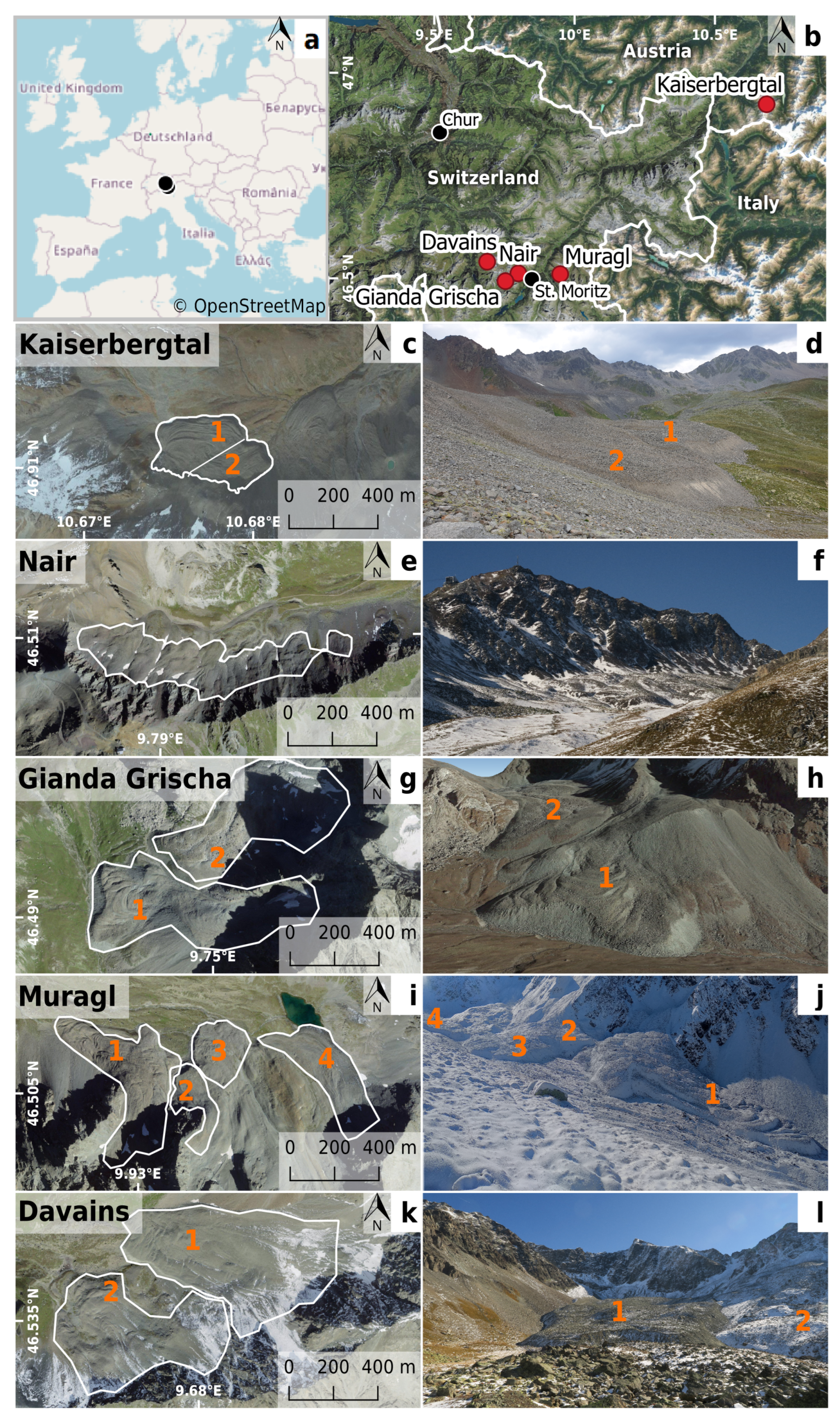
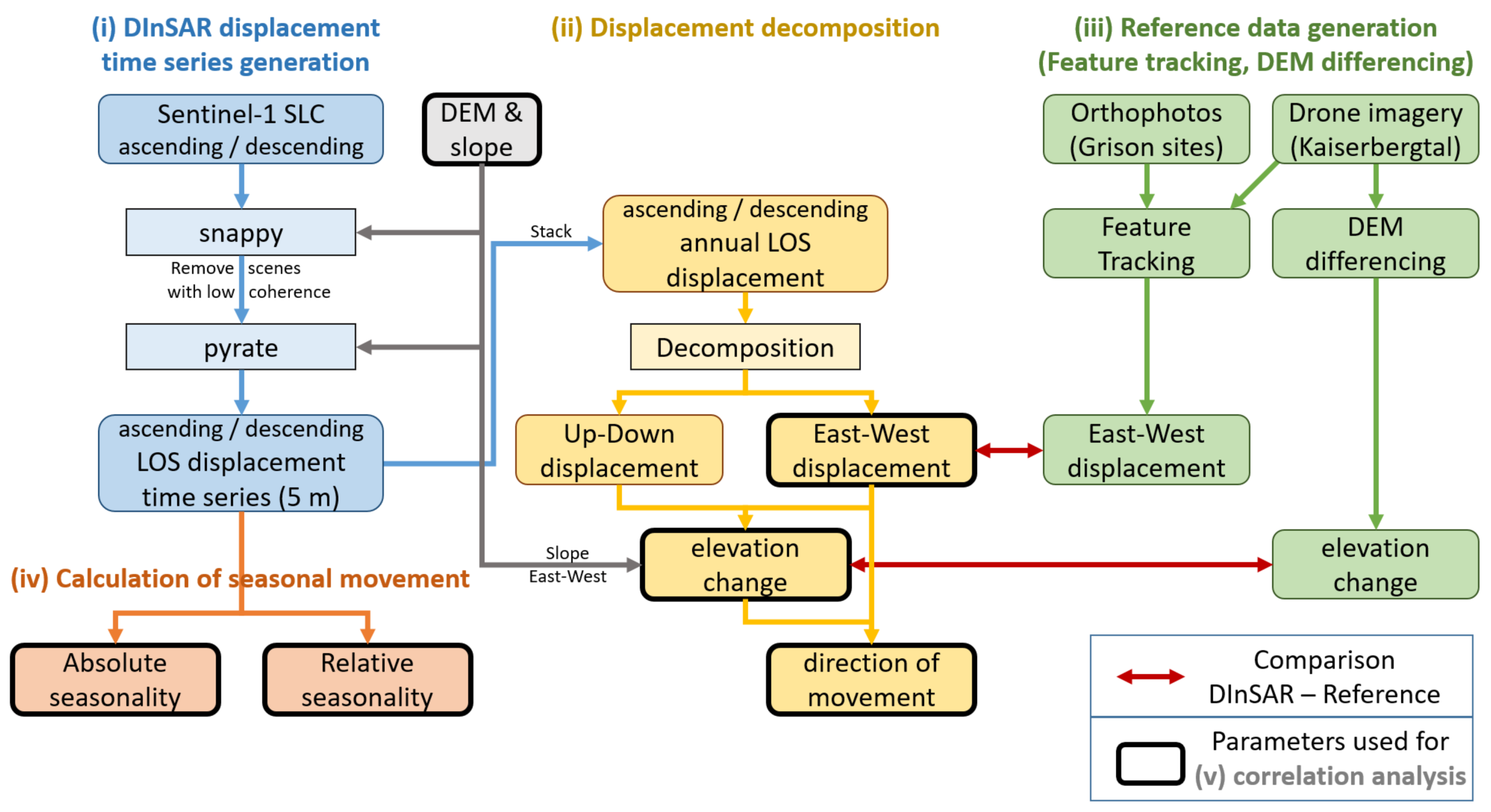
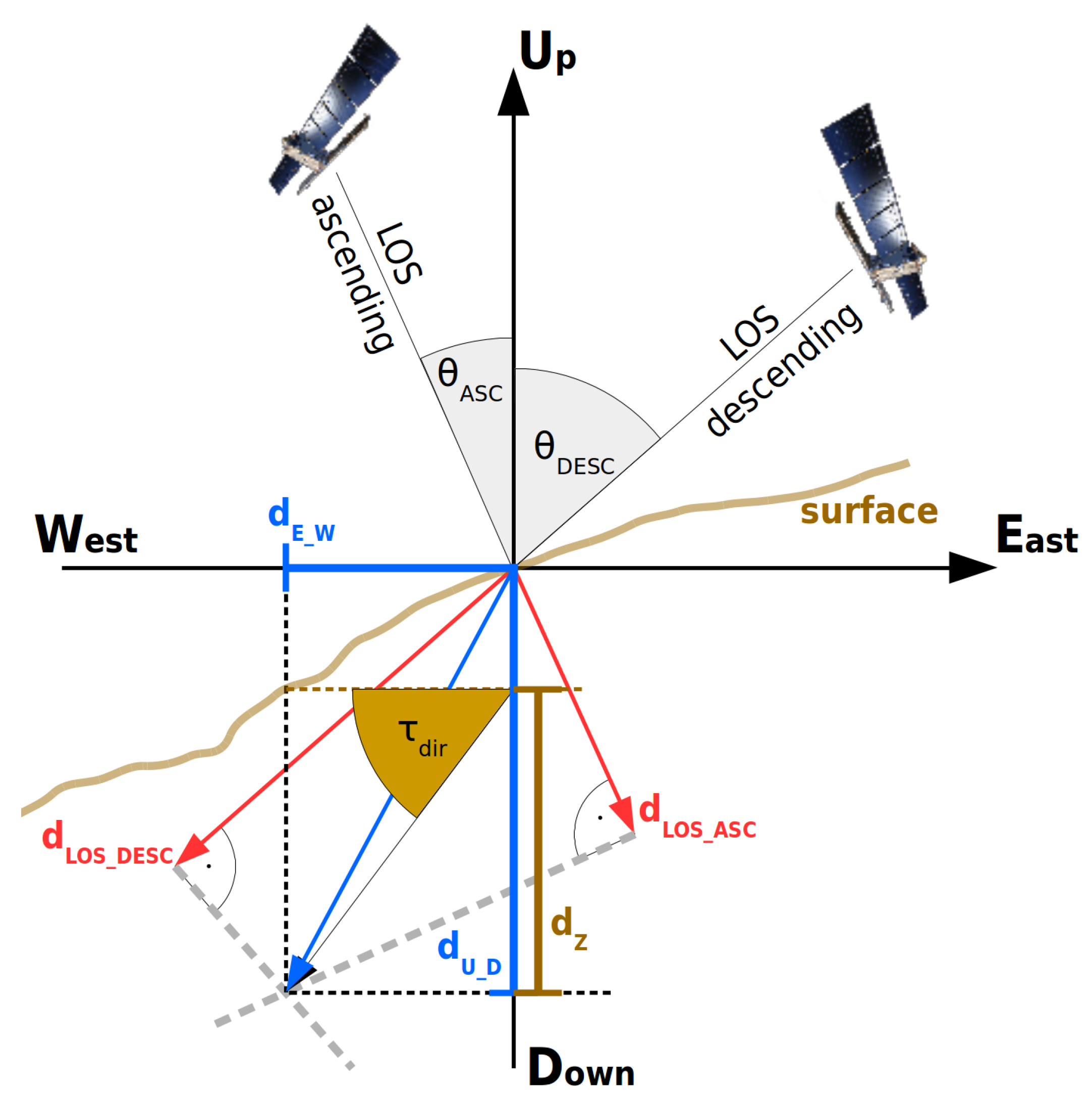
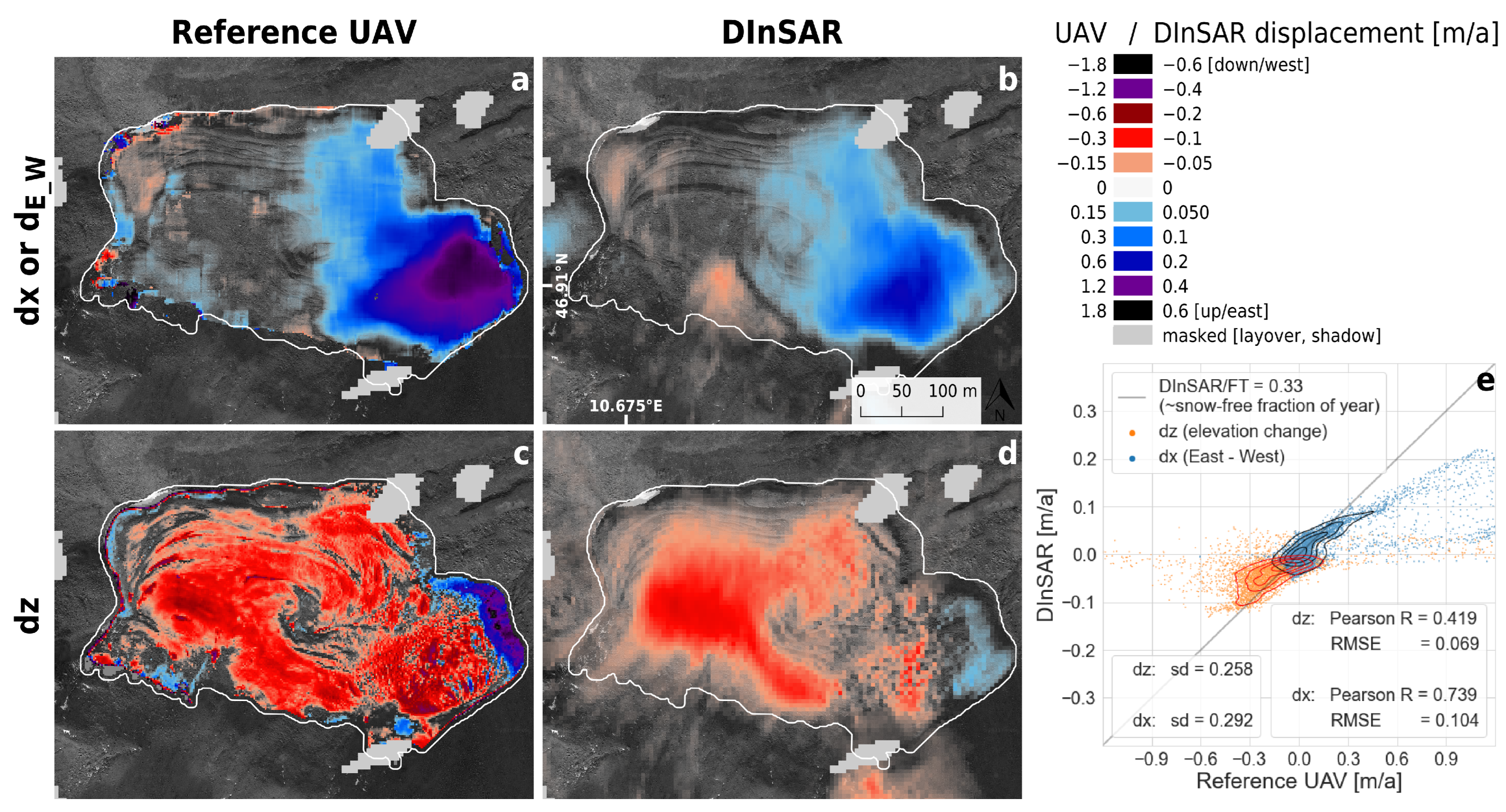
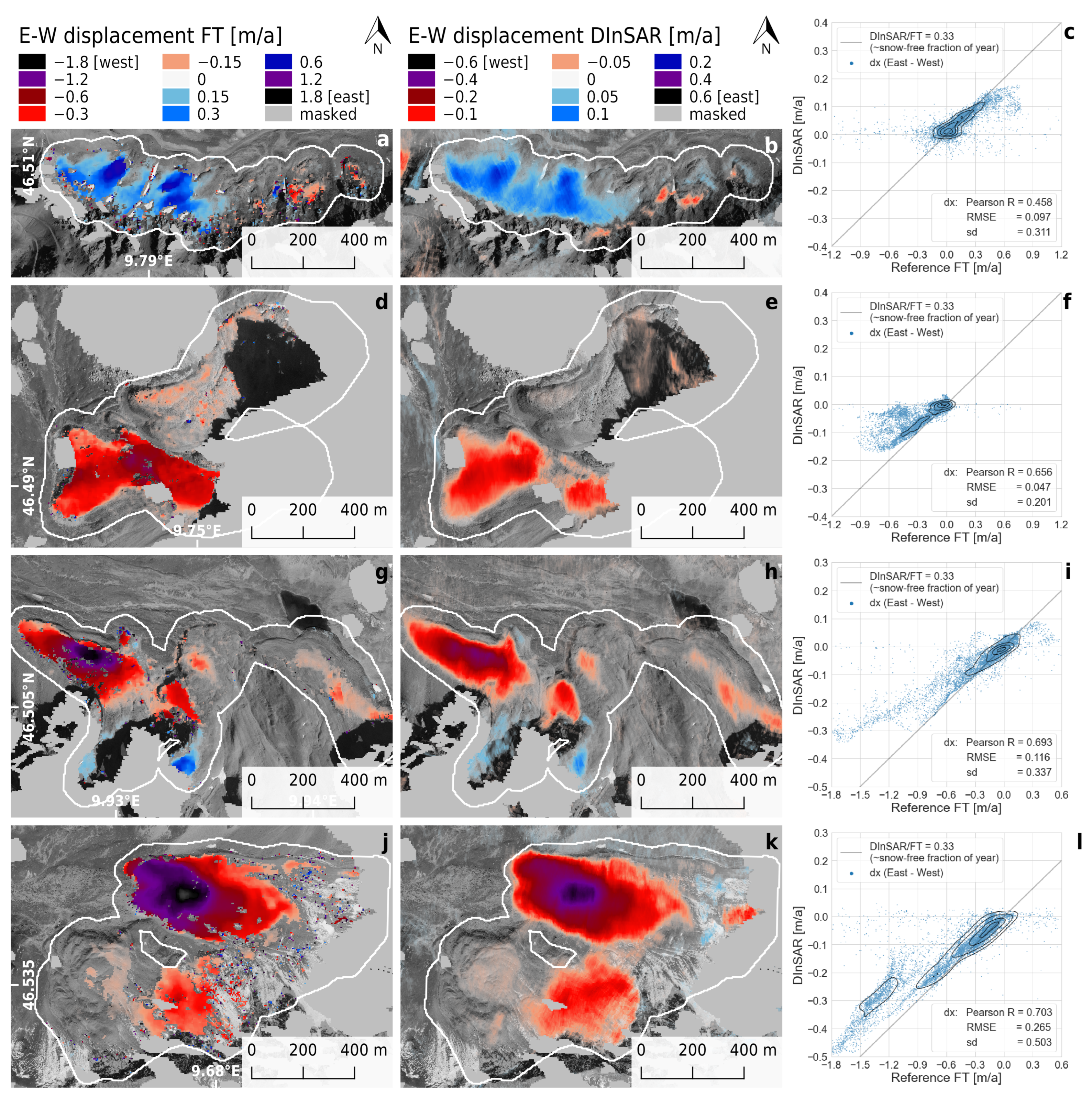
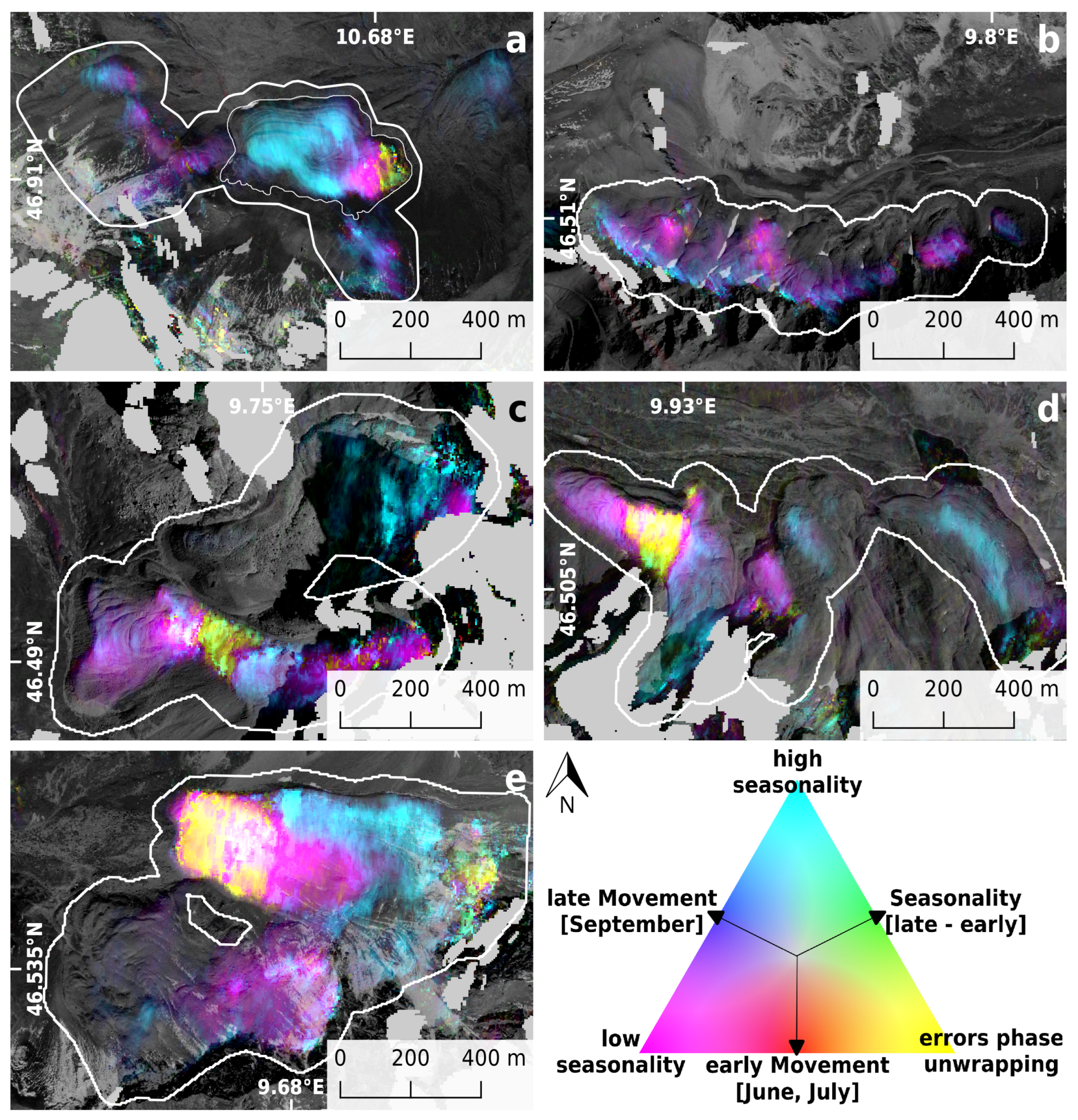
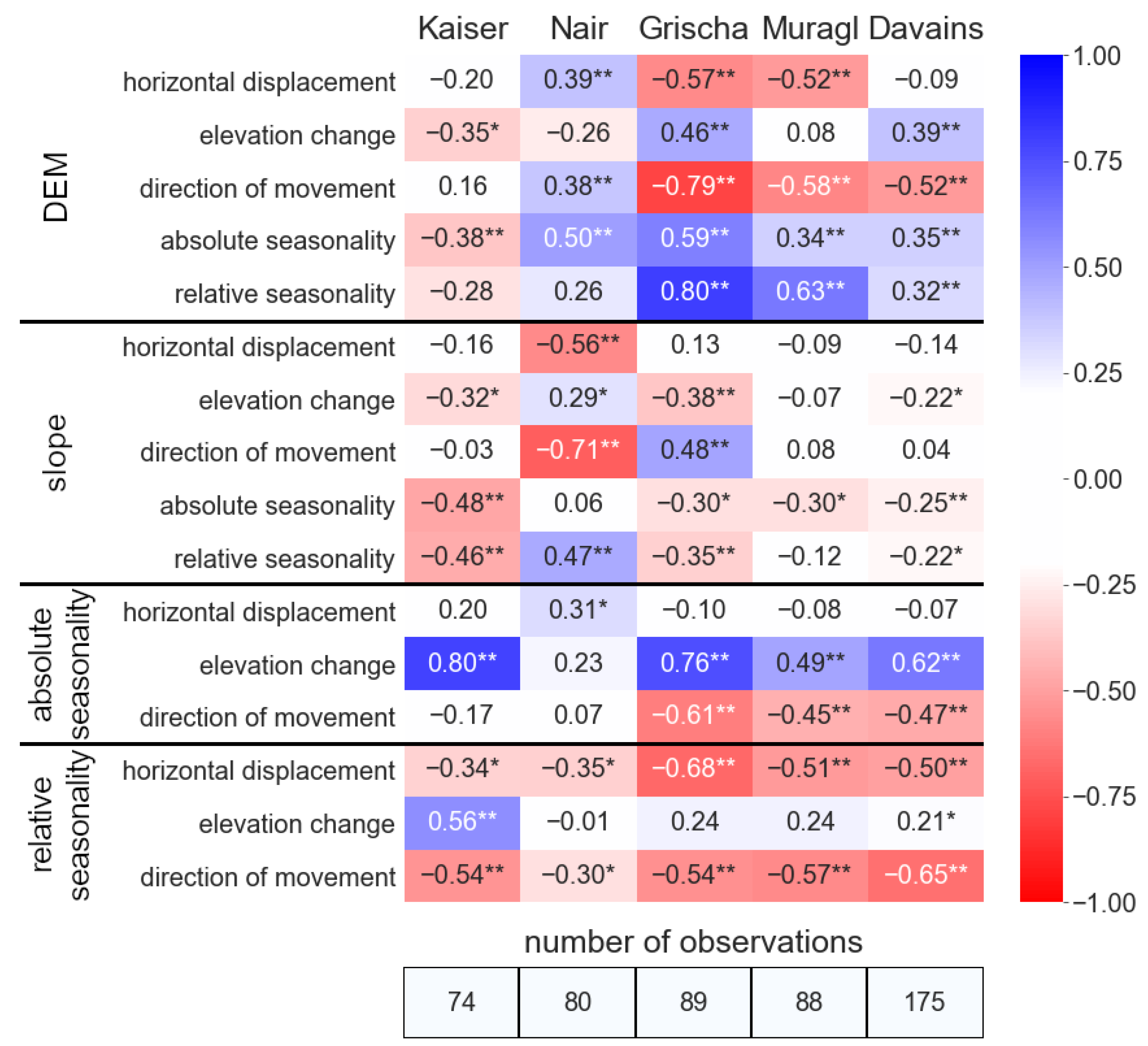

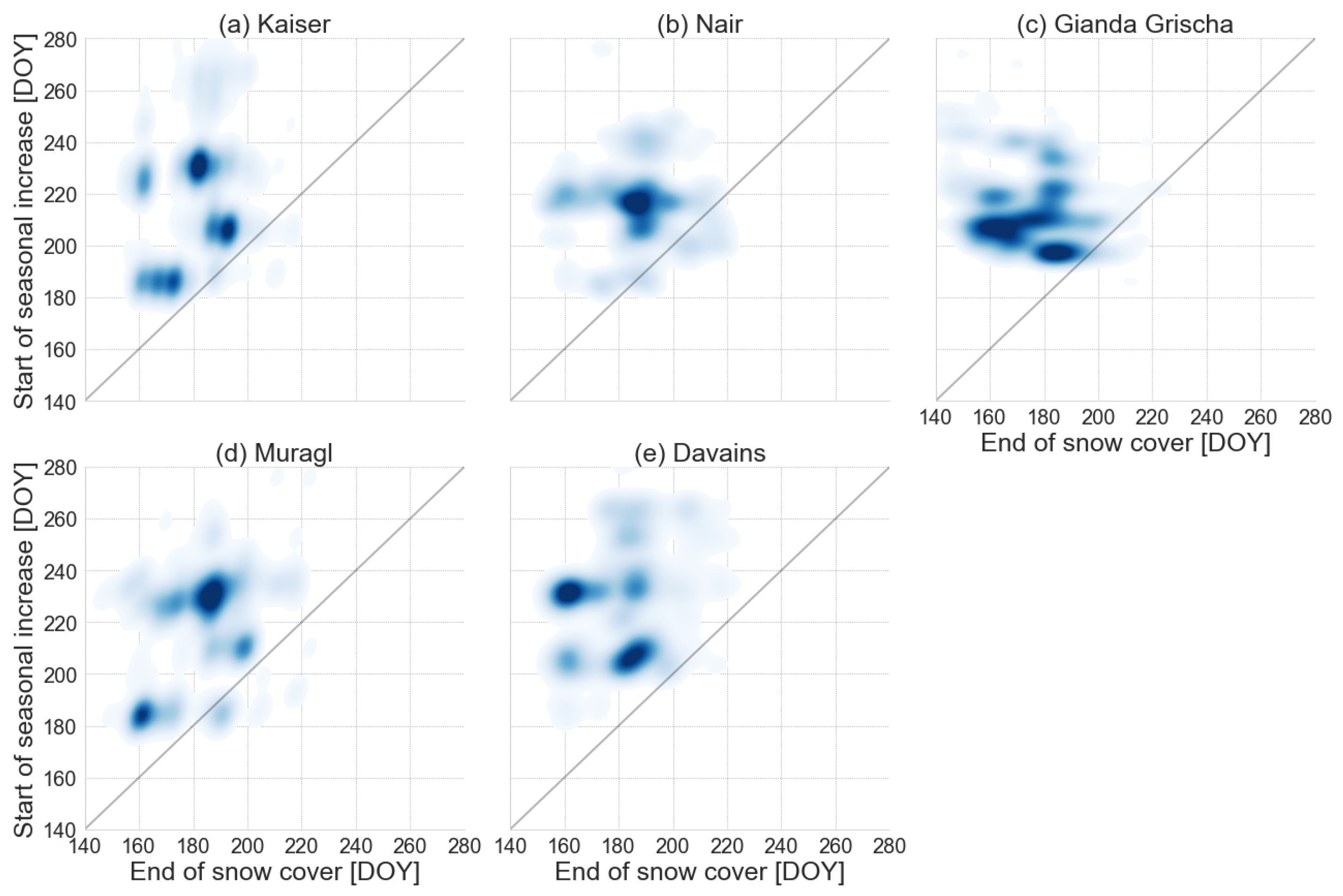
Disclaimer/Publisher’s Note: The statements, opinions and data contained in all publications are solely those of the individual author(s) and contributor(s) and not of MDPI and/or the editor(s). MDPI and/or the editor(s) disclaim responsibility for any injury to people or property resulting from any ideas, methods, instructions or products referred to in the content. |
© 2023 by the authors. Licensee MDPI, Basel, Switzerland. This article is an open access article distributed under the terms and conditions of the Creative Commons Attribution (CC BY) license (https://creativecommons.org/licenses/by/4.0/).
Share and Cite
Buchelt, S.; Blöthe, J.H.; Kuenzer, C.; Schmitt, A.; Ullmann, T.; Philipp, M.; Kneisel, C. Deciphering Small-Scale Seasonal Surface Dynamics of Rock Glaciers in the Central European Alps Using DInSAR Time Series. Remote Sens. 2023, 15, 2982. https://doi.org/10.3390/rs15122982
Buchelt S, Blöthe JH, Kuenzer C, Schmitt A, Ullmann T, Philipp M, Kneisel C. Deciphering Small-Scale Seasonal Surface Dynamics of Rock Glaciers in the Central European Alps Using DInSAR Time Series. Remote Sensing. 2023; 15(12):2982. https://doi.org/10.3390/rs15122982
Chicago/Turabian StyleBuchelt, Sebastian, Jan Henrik Blöthe, Claudia Kuenzer, Andreas Schmitt, Tobias Ullmann, Marius Philipp, and Christof Kneisel. 2023. "Deciphering Small-Scale Seasonal Surface Dynamics of Rock Glaciers in the Central European Alps Using DInSAR Time Series" Remote Sensing 15, no. 12: 2982. https://doi.org/10.3390/rs15122982
APA StyleBuchelt, S., Blöthe, J. H., Kuenzer, C., Schmitt, A., Ullmann, T., Philipp, M., & Kneisel, C. (2023). Deciphering Small-Scale Seasonal Surface Dynamics of Rock Glaciers in the Central European Alps Using DInSAR Time Series. Remote Sensing, 15(12), 2982. https://doi.org/10.3390/rs15122982








